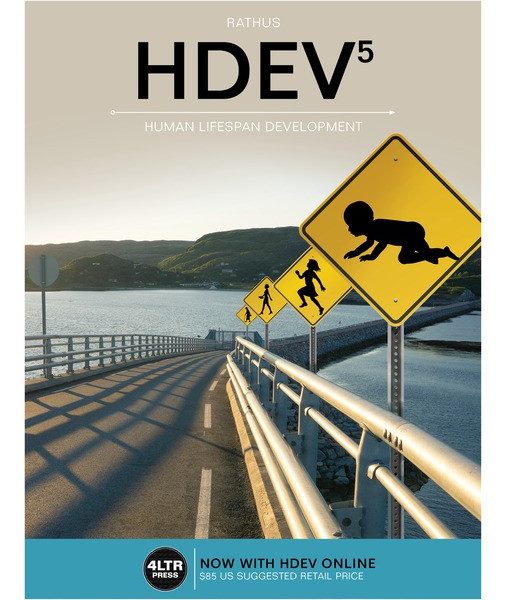Test Bank for HDEV 5th Edition by Rathus
$35.00 Original price was: $35.00.$26.50Current price is: $26.50.
Test Bank for HDEV 5th Edition by Rathus
Test Bank for HDEV 5th Edition by Rathus

Product details:
- ISBN-10 : 1337116882
- ISBN-13 : 978-1337116886
- Author: Spencer A. Rathus
Learn human development YOUR Way with HDEV! HDEV�s easy-reference, paperback textbook presents course content through visually-engaging chapters as well as Chapter Review Cards that consolidate the best review material into a ready-made study tool. With the textbook or on its own, HDEV Online allows easy exploration of HDEV anywhere, anytime – including on your device! Collect your notes and create StudyBits� from interactive content as you go to remember what�s important. Then, either use preset study resources, or personalize the product through easy-to-use tags and filters to prioritize your study time. Make and review flashcards, review related content, and track your progress with Concept Tracker, all in one place and at an affordable price!
Table contents:
- Ch 1: History, Theories, and Methods
- 1-1 The Development of the Study of Human Development
- 1-2 Theories of Development
- 1-3 Controversies in Development
- 1-4 How Do We Study Development?
- Ch 2: Heredity and Prenatal Development
- 2-1 The Influence of Heredity on Development
- 2-2 Heredity and the Environment
- 2-3 Conception: Against All Odds
- 2-4 Prenatal Development
- Ch 3: Birth and the Newborn Baby: In the New World
- Countdown . . .
- 3-1 The Stages of Childbirth
- 3-2 Methods of Childbirth
- 3-3 Birth Problems
- 3-4 The Postpartum Period
- 3-5 Characteristics of Neonates
- Ch 4: Infancy: Physical Development
- 4-1 Physical Growth and Development
- 4-2 Development of the Brain and Nervous System
- 4-3 Motor Development
- 4-4 Sensory and Perceptual Development
- Ch 5: Infancy: Cognitive Development
- 5-1 Cognitive Development: Jean Piaget
- 5-2 Information Processing
- 5-3 Individual Differences in Cognitive Functioning among Infants
- 5-4 Language Development
- Ch 6: Infancy: Social and Emotional Development
- 6-1 Attachment: Bonds That Endure
- 6-2 When Attachment Fails
- 6-3 Day Care
- 6-4 Emotional Development
- 6-5 Personality Development
- Ch 7: Early Childhood: Physical and Cognitive Development
- 7-1 Growth Patterns
- 7-2 Motor Development
- 7-3 Health and Illness
- 7-4 Sleep
- 7-5 Elimination Disorders
- 7-6 Jean Piaget’s Preoperational Stage
- 7-7 Factors in Cognitive Development
- 7-8 Theory of Mind
- 7-9 Development of Memory
- 7-10 Language Development: Why “Daddy Goed Away”
- Ch 8: Early Childhood: Social and Emotional Development
- 8-1 Dimensions of Child Rearing
- 8-2 Social Behaviors
- 8-3 Personality and Emotional Development
- 8-4 Development of Gender Roles and Gender Differences
- Ch 9: Middle Childhood: Physical and Cognitive Development
- 9-1 Growth Patterns
- 9-2 Motor Development
- 9-3 Disorders That Affect Learning
- 9-4 Cognitive Development
- 9-5 Moral Development: The Child as Judge
- 9-6 Information Processing: Learning, Remembering, Problem Solving
- 9-7 Intellectual Development, Creativity, and Achievement
- 9-8 Language Development and Literacy
- Ch 10: Middle Childhood: Social and Emotional Development
- 10-1 Theories of Social and Emotional Development in Middle Childhood
- 10-2 The Family
- 10-3 Peer Relationships
- 10-4 The School
- 10-5 Social and Emotional Problems
- Ch 11: Adolescence: Physical and Cognitive Development
- 11-1 Puberty: The Biological Eruption
- 11-2 Health in Adolescence
- 11-3 Cognitive Development: Piaget’s Stage of Formal Operations
- 11-4 Gender Differences in Cognitive Abilities
- 11-5 Moral Development
- 11-6 The Adolescent in School
- 11-7 Adolescents in the Workforce
- Ch 12: Adolescence: Social and Emotional Development
- 12-1 Development of Identity: “Who am I?”
- 12-2 Relationships with Parents and Peers
- 12-3 Sexuality
- 12-4 Juvenile Delinquency
- 12-5 Suicide: When the Adolescent Has Nothing-Except Everything-to Lose
- Ch 13: Early Adulthood: Physical and Cognitive Development
- 13-1 Emerging Adulthood
- 13-2 Physical Development
- 13-3 Health and Fitness
- 13-4 Sexuality
- 13-5 Cognitive Development
- 13-6 Career Development
- Ch 14: Early Adulthood: Social and Emotional Development
- 14-1 Separation
- 14-2 Intimacy versus Isolation
- 14-3 Seasons of Life
- 14-4 Attraction and Love: Forces That Bind?
- 14-5 Loneliness
- 14-6 The Single Life
- 14-7 Cohabitation: Darling, Would You Be My POSSLQ?
- 14-8 Marriage: Tying the Knot
- 14-9 Parenthood
- 14-10 Divorce: Breaking Bonds
- Ch 15: Middle Adulthood: Physical and Cognitive Development
- 15-1 Physical Development
- 15-2 Health
- 15-3 The Immune System
- 15-4 Sexuality
- 15-5 Cognitive Development
- 15-6 Creativity and Learning
- Ch 16: Middle Adulthood: Social and Emotional Development
- 16-1 Theories of Development in Middle Adulthood
- 16-2 Stability and Change in Middle Adulthood
- 16-3 Work in Middle Adulthood
- 16-4 Relationships in Middle Adulthood
- Ch 17: Late Adulthood: Physical and Cognitive Development
- 17-1 Physical Development
- 17-2 Theories of Aging
- 17-3 Health Concerns and Aging
- 17-4 Cognitive Development
- Ch 18: Late Adulthood: Social and Emotional Development
- 18-1 Theories of Social and Emotional Development in Late Adulthood
- 18-2 Psychological Development
- 18-3 Social Contexts of Aging
- 18-4 Retirement
- 18-5 Successful Aging
- Ch 19: Life’s Final Chapter
- 19-1 Understanding Death and Dying
- 19-2 Where People Die
- 19-3 Euthanasia: Is There a Right to Die?
- 19-4 Life-Span Perspectives on Death
- 19-5 Coping with Death
- Answers to Study Tools Questions
- References
- Name Index
- Subject Index
People also search:
what is 5 to the 5th
gdevelop 5 tutorial
mde 5th grade math standards
quest diagnostics 5th ave
Related products
Test Bank
Test Bank for Decision Support and Business Intelligence Systems, 9th Edition: Efraim Turban











